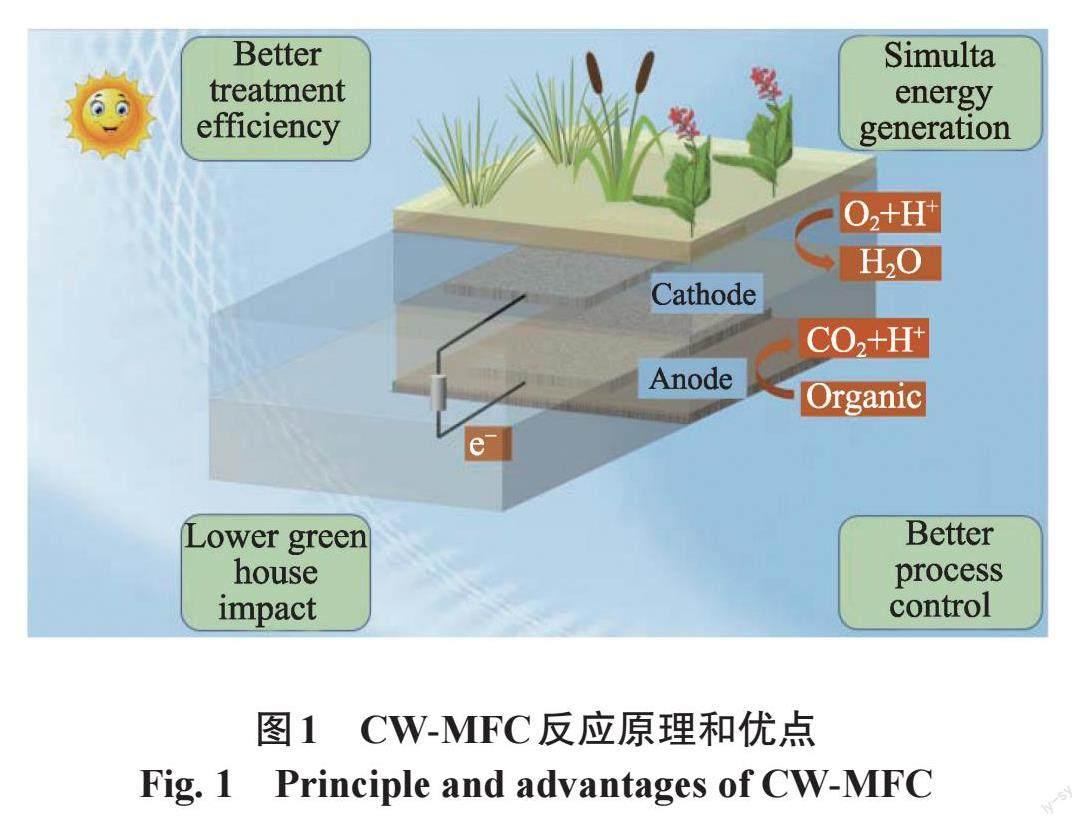人工湿地-微生物燃料电池中电极研究进展
2024-04-11吴同喜张环林欧阳军胜张军何厚柱杜致远彭小明
吴同喜 张环林 欧阳军胜 张军 何厚柱 杜致远 彭小明



摘要:【目的】近年來,人工湿地(CW)与微生物燃料电池(MFC)相耦合,形成了一种新型的生物电化学系统——人工湿地-微生物燃料电池(CW-MFC),具有出色的污染物降解和生物发电性能。本文旨在总结电极的特性和应用,介绍不同电极材料对系统的影响,最后对其未来的研究方向提出展望。【方法】结合国内外最新的研究成果。【结果】总结了电极的功能特性和应用,介绍了不同电极材料在废水处理过程中的性能差异以及对发电效率的影响,并对其未来的研究方向提出了展望,为CW-MFC的技术发展作进一步参考。【结论】CW-MFC是一种具有广泛应用前景的生物电化学系统。未来研究方向包括优化电极材料、提高系统运行效率、降低成本等方面。同时,还需要加强在实际应用中的研究,以推动该技术在环境保护和能源领域的应用。
关键词:人工湿地;微生物燃料电池;电极;污水处理
中图分类号:X70 文献标志码:A
本文引用格式:吴同喜,张环林,欧阳军胜,等. 人工湿地-微生物燃料电池中电极研究进展[J]. 华东交通大学学报,2024,41(1):120-126.
Research Progress of Electrodes in Constructed
Wetlands-Microbial Fuel Cells
Wu Tongxi1, Zhang Huanlin1, Ouyang Junshen1, Zhang Jun1, He Houzhu2, Du Zhiyuan2, Peng Xiaoming2,3
(1. China Communications Construction Qili Ancient Town (Ganzhou) Cultural Tourism Company Limited, Ganzhou 341000, China; 2. School of Civil Engineering and Architecture, East China Jiaotong University, Nanchang 330013, China;
3. State Key Laboratory of Pollution Control and Resource Reuse, Nanjing University, Nanjing 210023, China)
Abstract: 【Objective】 In recent years, constructed wetland (CW) coupled with microbial fuel cell (MFC) have formed a novel bioelectrochemical system, constructed wetland-microbial fuel cell (CW-MFC), with excellent pollutant degradation and bioelectricity generation performance. The aim of this paper is to summarise the characteristics and applications of the electrodes, introduce the effects of different electrode materials on the system, and finally provide an outlook on its future research directions. 【Methodology】 This paper combines the latest research results at home and abroad. 【Results】 The functional properties and applications of electrodes are summarised, followed by the performance differences of different electrode materials in the wastewater treatment process and their effects on the power generation efficiency, and finally an outlook on their future research directions is presented for further reference for the technological development of CW-MFC. 【Conclusion】 CW-MFC is a bioelectrochemical system with a wide range of applications. Future research directions include optimisation of electrode materials, improvement of system operation efficiency and cost reduction. At the same time, research in practical applications needs to be strengthened to promote the application of this technology in the fields of environmental protection and energy.
Key words: constructed wetland; microbial fuel cell; electrode; wastewater treatment
Citation format:WU T X, ZHANG H L, OUYANG J S, et al. Research progress of electrodes in constructed wetlands-microbial fuel cells[J]. Journal of East China Jiaotong University, 2024, 41(1): 120-126.
【研究意义】随着国家工业化进程的飞速发展,随之排放的多类型污废水的处理面临着新的挑战[1]。研究者们关注开发出可持续、高收益和友好节约型的水处理技术,以解决传统水处理技术的成本高、资源利用率低等问题。
【研究进展】人工湿地(conctructed wetland,CW)作为一种人为地将砂、石、土等基质按照特定的比例组合,并根据实际环境选择合适的植物种植的生态系统[2]。微生物燃料电池(microbial fuel cell,MFC)是微生物和电池技术相结合的产物,能够利用微生物作为催化剂净化废水的同时收获电能,受到人们广泛关注[3]。
鉴于CW系统自然分层的氧化还原梯度(基质下方厌氧和植物附近好氧)与MFC系统运行过程中阳极厌氧和阴极好氧环境高度拟合,为CW和MFC系统相耦合提供了可行性的条件[4]。Yadav在2010年的第十二届国际湿地系统水污染控制会议上首次报告了人工湿地-微生物燃料电池耦合系统(constructed wetland coupled with microbial fuel cell, CW-MFC),随后于2012年将耦合系统搭建并成功启动,用来处理偶氮染料浓度为500~2 000 mg/L的合成废水[5]。当进水中亚甲基蓝染料浓度为500 mg/L,水力停留时间96 h时,可获得93.13 %的染料去除率;进水染料浓度1 000 mg/L时,检测出最大功率密度和电流密度分别为15.73 mW/m2和69.75 mA/m2,由此开启了关于CW-MFC除污产电的研究。
【创新特色】CW-MFC系统作为一种新型废水处理技术,近年来得到研究学者的广泛关注,而针对CW-MFC系统中电极的研究较少。【关键问题】本文着重介绍CW-MFC中电极对系统除污能力和产电性能的影响及相关研究,同时对CW-MFC的应用前景进行了展望。
1 电极概述
将两种处理手段创新性的集成,打破CW和MFC技术的局限性,并将集成系统的处理能力加强,可实现废水处理的同时产生电量,如图1所示为系统原理和优点。电极的存在是区分CW和CW-MFC的重要依据,也是CW-MFC系统重要组成部分,在CW-MFC中分为处在厌氧环境的阳极和好氧环境的阴极。其中,阳极材料需要具有稳定性、对微生物无害且具备较好的导电性等[6]。阳极附近会聚集大量厌氧微生物,这些是处理废水和产生电能的关键,阳极材料须拥有较大的表面积为它们提供附着的场所,因此阳极材料的构型也会对处理效果产生影响[7]。阴极应选择氧化还原性能较强的材料,提升氧化还原反应速度,在基底负载催化剂可降低反应活化电势,进而提高反应速率[8]。阴阳极材料的合理选择对于CW-MFC能否达到预期的水处理效果和产电能力有很大的影响。根据以往的研究,虽然金属电极的导电性好,但由于在CW-MFC中电极材料处在废水和富含微生物的基质中,金属易被腐蚀,会对电极周围的微生物产生消极影响,且金属材料的孔隙率很低,限制了微生物附着在其表面[2]。鉴于以上原因,目前在CW-MFC中很少将纯金属当作电极材料。由于碳和石墨,具有较好的吸附能力、导电性良好、耐腐蚀、成本低廉且对微生物无毒等优点,常被用来制作电极的首选材料。此外,电极个数和埋深也会影响到CW-MFC系统的处理效果。
2 电极对CW-MFC的影响
电极作为CW-MFC系统中重要的标志,电极的材料、间距、面积及连接方式均会对系统的处理能力和产电效果产生影响,如表1为主要影响因素及产生的变化。
2.1 电极材料
电极材料的选择会影响CW-MFC工艺的除污和生物产电性能,应首选导电性好、电化学稳定、微生物相容性強作为电极材料[9]。理想的电极材料有足够大的表面积为微生物所附着,有效收集阳极产电菌所产出的电子,有利于CW-MFC系统处理效果[10]。在CW-MFC 研究中常用为电极的材料有石墨棒(graphite rod,GR)、泡沫镍(nickel foam,NF)、颗粒活性炭( granular activated carbon,GAC)、柱状活性炭(columnar activated carbon,CAC)、粉末活性炭(powdered activated carbon,PAC)、镁板(magnesium plate,MgP)、钛网(titanium mesh,TM)、不锈钢网(stainless steel mesh,SSM)、碳纤维毡(carbon fiber felt,CFF)等。由于碳基材料相对于其他材料来说,具有良好的化学稳定性、高比表面积、多孔性和价格便宜,它们被广泛应用于CW-MFC系统的电极中[11],但是碳基材料与金属材料相比会使系统的内阻变大,电导率下降将影响产电能力[12]。
Liu等[13]在上流式CW-MFC中比较了不锈钢网、碳布和颗粒活性炭三种电极材料的处理能力,其中GAC-SSM生物阴极取得了最好的处理效果,可达到的最大功率密度为55.05 mW/m2,与其他电极材料相比其表面积和毛细管吸水率也更大。Wang等[14]构建了碳纤维毡、不锈钢网、石墨棒和泡沫镍的下流式CW-MFC系统,均种植美人蕉作为湿地植物。表2列出了实验结果[14],碳纤维毡和石磨棒能够获得更好的除污效果,碳纤维毡和泡沫镍检测出更好的产电效果,同时这两种材料上Betaproteobacteria和Deltaproteobacteria两种产电菌的相对丰度较高,综合考虑碳纤维毡更适合用作电极材料。
Wang等[15]在下行垂直流CW-MFC中阴阳极采用泡沫镍FN处理污水,COD去除率达到37%,相对于采用SSM作为电极材料COD去除率达到47%,且SSM电极材料的微生物群落丰富度也高于FN。但是考虑到其金属极佳的导电性,将金属与碳基材料相结合形成集成电极,一些研究将SSM制作成外壳里面填充GAC,集成电极取得了极好的处理效果。在SSM内填充的活性炭,会由于活性炭的不同类型而产生不同的处理效果。Ji等[16]通过SSM内填充CAC柱状活性炭(长1~2 cm,直径0.8 cm)、GAC颗粒活性炭(直径1~2 mm),结果表明,在CW-MFC体系中填入GAC的环形阴极的最高电压为458 mV,最大功率密度为13.71 mW/m2,COD去除率为90%。填充颗粒活性炭具有更好的电子传递、更快速的电荷转移、更强的ORR动力学和更适宜微生物生长的环境,有利于生物发电性能的提高,因此未来的研究中应着重考虑使用颗粒活性炭作为电极材料。
2.2 阴阳电极间距
阴极为保持好氧环境,一般将其设置在液体-空气的交界处或植物根系周围,阴阳电极间距的改变,主要是阳极埋深的变化[17]。阴阳极电极间距的改变直接影响质子的传输距离,系统的内阻也随之改变,进而影响系统的处理能力和产电效果[18]。
Doherty等[19]将阴阳极间距设置为10 cm和210 cm,阴极设计在空气-水界面处,以猪废水为处理对象,在阴阳极间距为10 cm时,上流-下流组合进水的CW-MFC中得到了0.276 W/m2的最大功率密度。Mu等[20]设置5,10,15 cm电极间距处理含铬重金属废水,在间距10 cm处对六价铬和COD取得93.4%和88.3%最高去除率。
Ling等[21]设计了阴阳极间距为10~40 cm的四组CW-MFC反应器,研究发现系统产电能力在间距为20 cm时最佳,电压的大小随着阴阳极间距呈现先变大后变小的趋势。刘婷婷等[22]的研究也得到了相同的结果,设置电极间距分别为12,15,18 cm和20 cm用来处理污泥中的Zn和Ni,间距为12 cm时,对Zn,Ni的最高去除率可达到84.68%和74.14%,系统在间距为15 cm时取得最高的输出电压和功率密度。相关研究发现系统中离子和质子转移阻力和电极间距大小呈正相关关系,减小间距能降低转移阻力,系统内阻减小,进而获得更好的产电性能[23]。
同样秦歌等[24]通过调节阴阳极间距(10,15,20,25,30 cm和35 cm)处理高COD高氮污水,发现随着装置阴阳极间距的增加,污染物去除效率呈现先增加后减少的趋势,并在阴阳极间距为25 cm时达到最大值,对COD和氨氮的去除率达到86.00%和84.77%,电极间距增大阳极会靠近上流进水口,进水中少量溶解氧更易于到达阳极层破坏厌氧环境导致处理效果变差。但阴阳极间距一旦过小,阴极附近的溶解氧会进入阳极附近,会破坏阳极适宜的厌氧环境,使阳极附近微生物受到不利的影响,会降低产电菌的活性,导致产电能力下降,甚至出现短路等情况[25]。
2.3 电极面积及连接方式
电极面积与处理水体的接触面积、系统中微生物的生存空间及电子转移之间的效率息息相关,是目前提高反应速率的熱点方向之一。相关研究通过改变电极的形状、数量、阴极与空气之间的接触面积来改变电极的面积。
电极的形状决定CW-MFC系统中电极的有效反应面积和微生物生存的有效附着点[26]。Tang等[27]在研究初期使用水平放置的阴极,但由于阴极被生物膜覆盖,造成阴极上的生物污染,导致实验结果不理想。在后期研究中通过改为U型电极,发现U型阴极比水平放置在水面上的阴极更有利于生物电的产生。原因是水平放置的阴极上由于过度生长的生物膜,将阴极完全覆盖,显著抑制了氧向电极的扩散,阴极被迫处于厌氧环境,并降低了阴极电势,而U形阴极可以避免上述问题并加速了质子转移,从而加强了系统的处理能力。同样为增加阳极电极面积,范智仁[28]利用CW-MFC研究去除罗丹明B染料,将SSM折叠成波浪形,外部由塑料匝带固定5 mm厚的炭纤维毡,在实验中对罗丹明B染料平均去除率为(88.25±5.95)%。
阴阳极面积比的改变也会对系统产生影响,李薛晓等[29]通过研究阴阳极面积比为1、1.6、1.9和2.25的4组CW-MFC系统发现,出现了和电极间距变化规律相同的结果,系统电压在阴阳极面积比增加到1.9之前,一直呈现上升趋势,面积比增加到1.9后,系统的产电量逐渐减少。在阳极面积保持不变的情况下,阴极面积增加到一定的范围内,提供微生物的有利生存环境,极大地丰富微生物生物量,会促进阴极附近反应,加速消耗来自阳极的质子,进而解决阳极附近质子积累的现象,利于系统对污染物的去除和产电能力的提升[30]。因此在以后的研究中需要根据不同CW-MFC系统的特点选择最适合的阴阳极面积比。
为了获得更高的水处理能力、电输出功率,可以通过增加阴阳极数量来增加电极表面积从而为微生物提供更多的附着位点。Huang等[31]通过增加阳极和阴极的数量来对CW-MFC进行改进,多阳极的配置具有较大的活化表面积,增加了系统中H+和e-,实现了更高的功率输出。Xu等[32]验证了在CW-MFC中多阴极的可行性,系统内阻大小和阴极电极的个数呈现负相关关系,阴极个数增加会造成内阻减少,从而系统还原能力增强,实现了高电子传输和加强氮去除。为充分利用下层基质的厌氧环境,在CW-MFC中可引入多阳极的结构。Zhang等[33]进行了172 d的双阳极潮汐流CW-MFC研究,对COD、TN、TP分别能取得97.4%、83.4%和89.0%的去除率。多阳极的设计应注意最上层阳极与植物之间距离,湿地植物根系随着时间逐渐深入下方基质,植物根系泌氧会破坏周围厌氧环境,导致系统处理效果变差。Yang等[34]设置10和20 cm埋深的并联阳极,发现10 cm埋深的阳极因为植物根系过度生长会导致产电情况差于更深层的阳极。同时要注意多阳极会增加电子产量,阴极没有足够的电子受体接受阳极产生的电子,应考虑在阴极处设置曝气提供足够氧气作为电子受体[33]。
多电极的引入会使电极之间存在并联与串联两种连接方式,连接方式的不同会产生不同的处理结果。Tang等[27]发现CW-MFC中阳极并联的处理效果优于阳极串联,COD最高去除效果为91.7%、氨氮为97.3%、同时输出功率最高可达7.99 mW/m2。在对多阳极的研究中,多阳极并联比多阳极串联连接效果好,因为并联降低了系统的内阻并扩大了电流密度,如图2所示并联时可使阳极处于有利的工作状态从而产生更多的能量,使电流密度进一步提高[35]。
3 结束语
本文对电极在CW-MFC系统中的研究现况进行了总结归纳,从电极材料、电极数量、电极间距和电极面积及面积比等角度对CW-MFC处理效果的影响进行了阐述,电极对该系统具有很重要的影响,未来应加强对该部分的研究,以推动该技术在环境保护和能源领域的应用。
在CW-MFC系统中,由生物、化学、物理的共同作用下降解污染物和生物产电。近年来,该耦合系统在处理污水的研究逐渐展开并取得了一定的成果。对未来CW-MFC研究,应以新技术新方法为手段,重点开展以下几个方面的研究:
1)针对去除不同污染物探究出最适合的电极材料及其他运行参数,突破现有小试研究模式,推广中试实验,为尽快运用到工程实际提供理论基础;
2)对CW-MFC系统释放的温室气体与系统组成和运行方式开展研究,找出降低温室气体排放量的影响参数;
3)加强如不锈钢网包裹活性炭的复合电极材料的研究,找出复合电极与其他单一电极的优势之处并找出处理机理;
4)未来的CW-MFC研究须关注提高污染物去除率和电力输出,尤其是解决高有机物浓度下CW-MFC处理效果不佳和低有机物浓度下电力输出低的问题。
参考文献
[1] 聂发辉, 刘荣荣, 刘占孟. 富营养化景观水体的处理技术及相关研究进展[J]. 华东交通大学学报, 2014, 31(2): 72-78.
NIE F H, LIU R R, LIU Z M. Treatment technology of eutrophication landscape waters[J]. Journal of East China Jiaotong University, 2014, 31(2): 72-78.
[2] 石玉翠, 罗昕怡, 唐刚, 等. 人工湿地-微生物燃料电池耦合系统的研究进展及展望[J]. 环境工程, 2021, 39(8):25-33.
SHI Y C, LUO X Y, TANG G, et al. Research progress and prospects of constructed wetland-microbial fuel cell coupling system[J]. Environmental Engineering, 2021, 39(8):25-33.
[3] PRIYA A K, SUBHA C, KUMAR P S, et al. Advancements on sustainable microbial fuel cells and their future prospects[J]. Environmental Research, 2022, 210: 112930.
[4] SUPRIYA G, PRATIKSHA S. A comprehensive review on emerging constructed wetland coupled microbial fuel cell technology[J]. Bioresource Technology, 2021, 320(B):124376.
[5] YADAV A K, DASH P, MOHANTY A, et al. Performance assessment of innovative constructed wetland-microbial fuel cell for electricity production and dye removal[J]. Ecological Engineering, 2012, 47: 126-131.
[6] 孫齐, 韩严和, 齐蒙蒙. 微生物燃料电池应用及性能优化研究进展[J]. 工业水处理, 2020, 40(7): 6-11.
SUN Q, HAN Y H, QI M M. Research progress on application and performance optimization of microbial fue cells [J]. Industrial Water Treatment, 2020, 40(7): 6-11.
[7] KONG S T, ZHAO J T, LI F, et al. Advances in anode materials for microbial fuel cells[J]. Energy Technology, 2022, 10(12): 2200824.
[8] JIN X J, GUO F, MA W Q, et al. Heterotrophic anodic denitrification improves carbon removal and electricity recovery efficiency in microbial fuel cells[J]. Chemical Engineering Journal, 2019, 370: 527-535.
[9] HUANG X, DUAN C S, DUAN W Y, et al. Role of electrode materials on performance and microbial characteristics in the constructed wetland coupled microbial fuel cell (CW-MFC)[J]. Journal of Cleaner Production, 2021, 301: 126951.
[10] PALANISAMY G, JUNG H Y, SADHASIVAM T, et al. A comprehensive review on microbial fuel cell technologies[J]. Journal of Cleaner Production, 2019, 221: 598-621.
[11] LI Y, STYCZYNSKI J, HUANG Y K, et al. Energy-positive wastewater treatment and desalination in an integrated microbial desalination cell(MDC)-microbial electrolysis cell(MEC)[J]. Journal of Power Sources, 2017, 356: 529-538.
[12] SRIVASTAVA P, YADAV A K, MISHRA B K. The effects of microbial fuel cell integration into constructed wetland on the performance of constructed wetland[J]. Bioresource Technology, 2015, 195: 223-230.
[13] LIU S T, SONG H L, WEI S, et al. Bio-cathode materials evaluation and configuration optimization for power output of vertical subsurface flow constructed wetland[J]. Bioresource Technology, 2014, 166:575-583.
[14] WANG J F, SONG X S, WANG Y H, et al. Effects of electrode material and substrate concentration on the bioenergy output and wastewater treatment in air-cathode microbial fuel cell integrating with constructed wetland[J]. Ecological Engineering, 2017, 99: 191-198.
[15] WANG J F, SONG X S, WANG Y H, et al. Microbial community structure of different electrode materials in constructed wetland incorporating microbial fuel cell[J]. Bioresource Technology, 2016, 221: 697-702.
[16] JI B, ZHAO Y Q, YANG Y, et al. Insight into the performance discrepancy of GAC and CAC as air-cathode materials in constructed wetland-microbial fuel cell system[J]. Science of the Total Environment, 2022, 808: 152078.
[17] LIU R, CHEN Y H, WU J M, et al. In situ COD monitoring with use of a hybrid of constructed wetland-microbial fuel cell[J]. Water Research, 2022, 210: 117957.
[18] WANG H C, CUI D, YANG L H, et al. Increasing the bio-electrochemical system performance in azo dye wastewater treatment[J]. Bioresource Technology, 2017, 245: 962-969.
[19] DOHERTY L, ZHAO X H, ZHAO Y Q, et al. The effects of electrode spacing and flow direction on the performance of microbial fuel cell-constructed wetland[J]. Ecological Engineering, 2015, 79: 8-14.
[20] MU C X, WANG L, WANG L. Performance of lab-scale microbial fuel cell coupled with unplanted constructed wetland for hexavalent chromium removal and electricity production[J]. Environmental Science and Pollution Research International, 2020, 27(20): 25140-25148.
[21] LI X, SONG H, XIANG W, et al. Electricity generation during wastewater treatment by a microbial fuel cell coupled with constructed wetland[J]. Journal of Southeast University (English Edition), 2012, 28(2): 175-178.
[22] 刘婷婷, 徐大勇, 王璐, 等. 电极间距对CW-MFC处理污泥中Zn和Ni的效果及其产电性能的影响[J]. 化工进展, 2021, 40(7): 4074-4082.
LIU T T, XU D Y, WANG L, et al. Effect of electrode spacing on the removal of Zn and Ni in sludge and its electricity generation performance by CW-MFC[J]. Chemical Industry and Engineering Progress, 2021,40 (7):4074-4082.
[23] 王艳芳, 刘百仓, 郑哲, 等. 电极面积和电极间距对立方体型MFCs产电能力的影响[J]. 可再生能源, 2013, 31(8):68-74.
WANG Y F, LIU B C, ZHENG Z, et al. Effects of the electrode area and electrode spacing on the electricity generation capacity of MFCs[J]. Renewable Energy Resources, 2013, 31(8): 68-74.
[24] 秦歌, 陳婧, 余仁栋, 等. 人工湿地-微生物燃料电池对高碳氮废水的强化净化和产电研究[J]. 湿地科学与管理, 2021, 17: 12-17.
QIN G, CHEN J, YU R D, et al. Enhanced nitrogen removal and electricity generation efficiency by constructed wetland-microbial fuel cell[J]. Wetland Science & Management, 2021, 17(4): 12-17.
[25] DOHERTY L, ZHAO Y Q, ZHAO X H, et al. Nutrient and organics removal from swine slurry with simultaneous electricity generation in an alum sludge-based constructed wetland incorporating microbial fuel cell technology[J]. Chemical Engineering Journal, 2015, 266: 74-81.
[26] ?A?DA? S, CENGIZ T, CAN T O, et al. Effect of vegetation type on treatment performance and bioelectric production of constructed wetland modules combined with microbial fuel cell (CW-MFC) treating synthetic wastewater[J]. Environmental Science and Pollution Research International, 2018, 25(9): 8777-8792.
[27] TANG C, ZHAO Y Q, KANG C, et al. Towards concurrent pollutants removal and high energy harvesting in a pilot-scale CW-MFC: Insight into the cathode conditions and electrodes connection[J]. Chemical Engineering Journal, 2019, 373: 150-160.
[28] 范智仁. 人工湿地—微生物燃料电池去除罗丹明B染料 [D]. 西安: 长安大学, 2017.
FAN Z R. Enhanced removal of rhodamine B(dye) by constructed wetland incorporating microbial fuel cell[D]. Xi'an: Chang'an University, 2017.
[29] 李薛晓, 程思超, 方舟, 等. 湿地基质及阴极面积对人工湿地型微生物燃料电池去除偶氮染料同步产电的影响 [J]. 环境科学, 2017, 38(5): 1904-1910.
LI X X, CHENG S C, FANG Z, et al. Effects of microbial fuel cell coupled constructed wetland with different support matrix and cathode areas on the degradation of azo dye and electricity production[J]. Environmental Science, 2017, 38(5): 1904-1910.
[30] 程思超, 方舟, 李薛晓, 等. 共基质对人工湿地型微生物电池脱色染料并产电的影响[J]. 水处理技术, 2016, 42:44-48.
CHENG S C, FANG Z, LI X X, et al. Effects of co-substrates onsimultaneous decolorization of azo dye and bioelectricitygeneration in microbial fuel cell coupled constructed wetland[J]. Technology of Water Treatment, 2016,42(10): 44-48.
[31] HUANG S, ZHU G C, GU X. The relationship between energy production and simultaneous nitrification and denitrification via bioelectric derivation of microbial fuel cells at different anode numbers[J]. Environmental Research, 2020, 184(10): 109247.
[32] XU L, ZHAO Y Q, WANG X D, et al. Applying multiple bio-cathodes in constructed wetland-microbial fuel cell for promoting energy production and bioelectrical derived nitrification denitrification process[J]. Chemical Engineering Journal, 2018, 344: 105-113.
[33] ZHANG K, YANG S Q, LUO H B, et al. Enhancement of nitrogen removal and energy recovery from low C/N ratio sewage by multi-electrode electrochemical technology and tidal flow via siphon aeration[J]. Chemosphere, 2022, 299:134376.
[34] YANG Y, ZHAO Y Q, TANG C, et al. Dual role of macrophytes in constructed wetland-microbial fuel cells using pyrrhotite as cathode material[J]. Chemosphere, 2020, 263: 128354.
[35] ESTRADA A E B, HERN?NDEZ R J, GARC?A S L, et al. Domestic wastewater treatment and power generation in continuous flow air-cathode stacked microbial fuel cell[J]. Journal of Environmental Management, 2018, 214: 232-241.
第一作者:吳同喜(1982—),男,高级工程师,研究方向为污水处理和生物质能源利用技术。E-mail: 41792595@ qq.com。
通信作者:何厚柱(1999—),男,硕士研究生,研究方向为人工湿地-微生物燃料电池。E-mail: 2320206138@qq.com。
